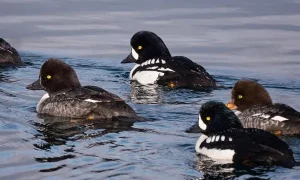When winter’s grip tightens on the Chesapeake Bay near Annapolis, a special visitor arrives from the northern forests – the common goldeneye. These striking diving ducks bring a dramatic dimorphism to our waters, with males sporting gleaming white sides, deep green-black heads, and their namesake brilliant golden eyes. Females, though more subtle in their chocolate-brown heads and gray bodies, share those remarkable amber eyes that seem to glow against the winter waters of the South River.

These hardy ducks are purely winter residents in our region, typically arriving on the Chesapeake’s waters in late November and departing by March for their breeding grounds in the boreal forests of Canada. Unlike our resident waterfowl, goldeneyes never nest along the Bay’s shores – they’re committed to the northern wilderness where they seek out tree cavities, sometimes 40 feet high, for their summer nesting sites.
Along the South River and broader Chesapeake Bay, goldeneyes typically gather in small to medium-sized flocks, often mixing with other diving ducks like buffleheads and scaup. These winter groupings favor the deeper waters of the main river channels and bay proper, though they’ll move into protected coves during storms or when feeding on particularly rich underwater beds of shellfish.
For visitors cruising Annapolis waters in winter, goldeneyes provide some of the most entertaining waterfowl watching. Males perform elaborate courtship displays right through the winter months, throwing their heads back until they touch their backs, kicking up sprays of water with their feet, and making short rushes across the surface. These theatrical performances, accompanied by distinctive whistling sounds from their wings in flight, earn them the waterfowler’s nickname “whistlers.”
Their feeding behavior is equally fascinating to watch. Unlike dabbling ducks that tip up in shallow water, goldeneyes are accomplished divers, plunging beneath the surface in search of crustaceans, mollusks, and small fish. They’re particularly fond of the South River’s beds of small clams and crabs, their strong bills perfectly adapted for prying prey from the bottom. Watch for their coordinated diving behavior – when one surfaces, another often dives, creating a continuous rotation of feeding activity.
The arrival of goldeneyes each winter marks an important season in the Chesapeake’s annual cycle. These northern visitors join the Bay’s remarkable winter waterfowl congregation, transforming our waters into one of North America’s most important wintering grounds for diving ducks. Their presence in the waters around Annapolis speaks to the continuing ecological significance of the Bay, even in the coldest months.
As winter progresses, the courtship activities of the goldeneyes increase in frequency and intensity. Though they won’t nest here, pair bonds formed on our waters will carry through to their northern breeding grounds. The males’ distinctive head-throwing display becomes more frequent in February, creating spectacular shows for observers lucky enough to be cruising the South River on calm winter mornings.
For boaters exploring the Chesapeake in winter, goldeneyes offer special viewing opportunities. Unlike some more wary species, they often allow relatively close approach if boats maintain a steady course and speed. Early morning and late afternoon typically provide the best viewing conditions, when the low winter sun illuminates their striking plumage and those remarkable golden eyes.
So during your winter explorations of the South River and Chesapeake Bay, watch for these elegant diving ducks among the winter waterfowl flocks. Whether you’re witnessing their energetic courtship displays, observing their coordinated feeding dives, or simply admiring the contrast between brilliant males and elegant females, you’re watching one of the Bay’s most charismatic winter residents. In their annual return to our waters, goldeneyes remind us that the Chesapeake serves as a crucial link in the great chain of seasonal bird movements across North America.
